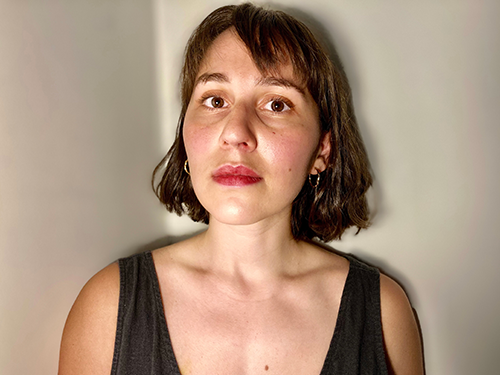Sarah Marks Mininsohn, an MFA candidate in Dance, is a 2021–22 HRI Graduate Student Fellow. In today’s post, she shares a glimpse into her fellowship research project, “Performance Nests: Choreographing Frameworks for Instability and Contamination.” Learn more about HRI’s Campus Fellowship program, which supports a cohort of faculty and graduate students through a year of dedicated research and writing in a collaborative, interdisciplinary environment.
Art historian Hal Foster draws connection between the words precarity and prayer, which share a Latin root meaning: dependence on the favor of another, or, outside of one’s control. As I choreograph and write, I research the precarity of performing in proximity to one another, with six dancers and three Klezmer musicians sharing a small stage, blending rhythmic and melodic qualities, and lasting only a fleeting duration before ending. The pandemic intensifies the precarity of the dance. After extended constraints of Zoom and social distancing, the joy, intimacy, and unknowing of dancing close together (knowing we still risk returning to socially distanced dancing) feels prayer-like.
“The dance evolves out of a construction process. There will be closeness and breath for thirty minutes, and then it will disappear, its fragments finding new life somewhere else.”
I examine the nest, specifically the bird’s nest, as a framework for researching this fleeting-yet-intimate nature of live dance, in relation to broader environmental instability. I consider a number of nest-meanings, for example, a construction where a bird rears its young, or a family home one might return to. Researching the nest in its various associations, I’ve woven together a loose working definition for the act of nesting, to draw connection between my choreographic process and the nest itself: nest (v): to intuitively and strategically situate objects and ideas into encounter, creating a storied architecture that supports life for a duration of time before disintegrating.
Musicians: Cody Jensen, Charlie Harris, and Frances Harris. Process video provided by Sarah Marks Mininsohn.
By “storied,” I mean formed by encounters between objects, each embedded with histories. As I consider the nest’s “storied-ness,” I resist the notion that it exists purely in the natural world, outside human influence. Rather, birds strategically construct nests from found materials in their vicinities, often pulling objects thought to be “human” (bits of plastic bags, microplastics, and radiation) and “nature” (twigs, mosses, and feathers). These materials, visible and invisible, interact with one another, causing contamination while also adding structural support. They demonstrate an impossibility of purity, as materials that cause death under some circumstances become repurposed to support life. After the nest disintegrates, its fragments flow into different structures and systems, and in the case of plastics and radiation, outlast the birds and humans that interacted with them. The nest’s timeline may seem brief, but the structure holds life (and death, perhaps mourning), before releasing into other forms. I apply this lifespan to the fleeting dance performance: brief, yet storied and significant, a togetherness composed of seemingly disparate fragments.
This investigation involves researching birds, but I don’t claim to be an ornithologist. My dance explores interactions between humans, and includes few direct nest images. Rather than a creating a dance that directly performs the nest, I develop choreographic methods that converse with nesting in process. The methods (such as compiling found objects to complicate spatial relationships, or pulling from musical structures to form encounters between disparate rhythms even if they “contaminate” purity of genre) allow the framework of nesting to emerge through the dance’s form, more than its content. The dance evolves out of a construction process. There will be closeness and breath for thirty minutes, and then it will disappear, its fragments finding new life somewhere else.
Images and video provided by Sarah Marks Mininsohn
